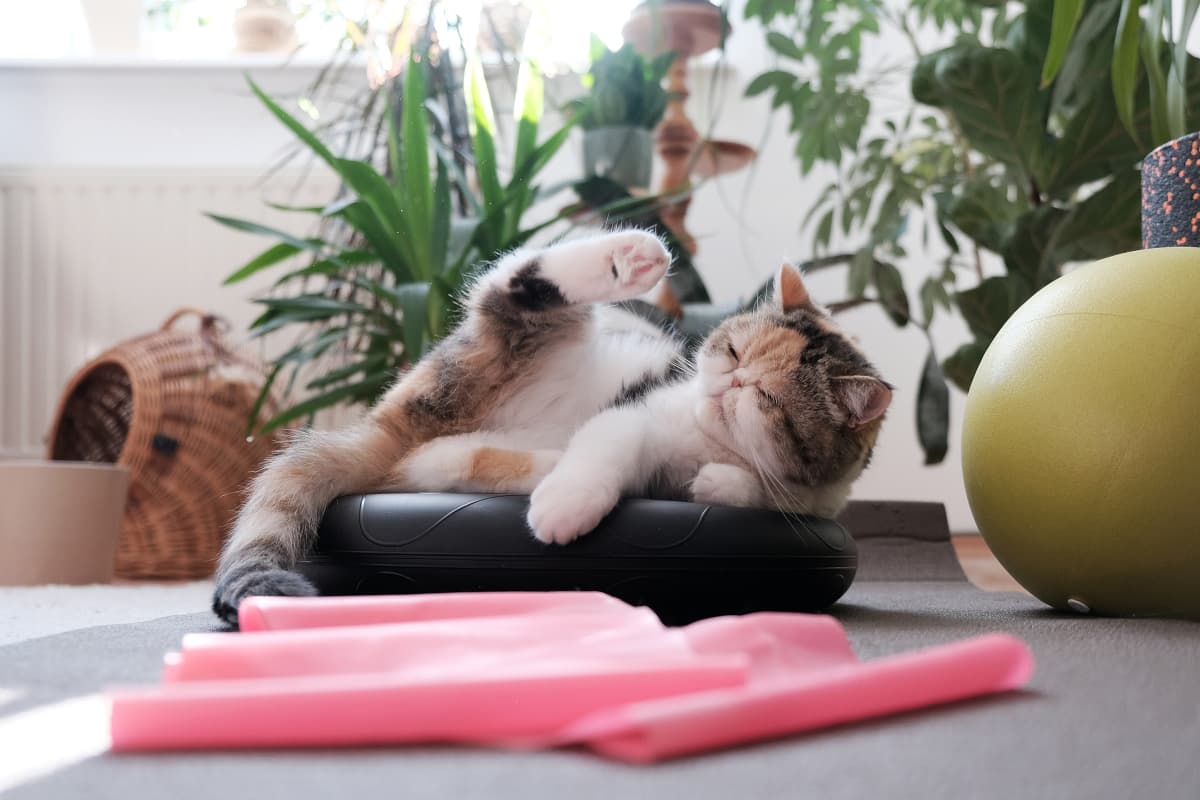
Is your cat lazy? Most cats get less daily exercise than they should. While not all cats are naturally active, encouraging them with some fun and simple cat exercises can help them stay healthy.
A typical cat will sleep around 12 to 15 hours per day. In fact, studies have shown that older cats can sleep up to 20 hours per day. Such a sedentary lifestyle often leads to weight gain and other health problems, which is why many pet owners make cat exercise a daily goal.
In this blog, we’ll help you understand your cat’s schedule, some basic cat exercises and how to encourage your cat to stay active.
How Much Exercise Do Cats Need?
How much cat exercise is appropriate for your kitty?
Every cat is different, and their physical routine can be affected by health, age, and lifestyle.
A good rule of thumb is to try to incorporate 30 minutes of moderate activity every day. This can include running, jumping, climbing, and chasing, just to name a few.
An indoor cat will need you to be more involved in their daily activity, while outdoor cats have ample opportunity to work out by climbing, jumping, and hunting.
When learning how long you should play with your cat, just let your cat take charge. Your cat will play only for as long as the animal feels engaged. Most cats have notoriously short attention spans and will only show interest in a toy for a fleeting time before wandering off in search of food or a nap.
Understanding Your Cat’s Schedule
Cats are commonly thought to be nocturnal, but they are actually crepuscular, meaning they are the most active at sundown and sunup.
The easiest way to introduce more activity in your cat’s routine is to plan cat exercise around their peak active hours. Plan your cat’s activities in the morning and the evening when possible.
If you have an indoor cat, you may find that she is more capable of adapting to your schedule, but the most effective times to encourage play and cat exercise are still morning and evening.
Why is My Cat Lazy?
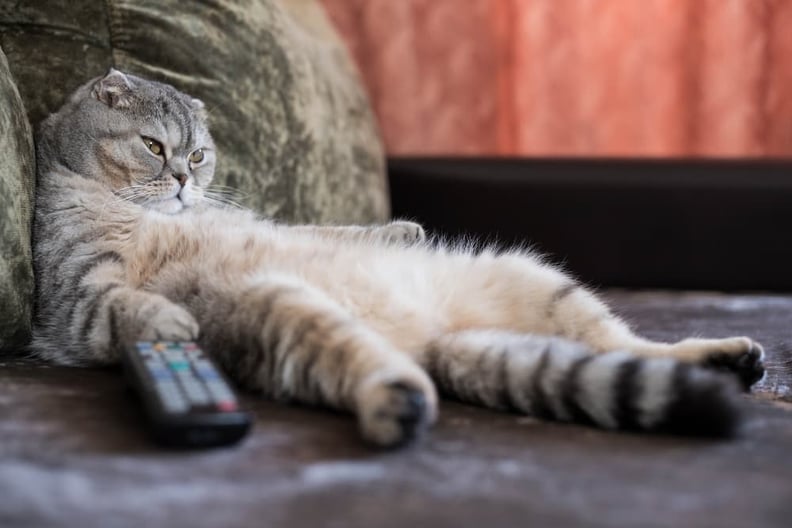
If your cat is prone to being a lazy couch potato, it can be a challenge to get them off their cat butts and chase a toy. If you are struggling to get your cat to be more active, then there may be an underlying cause. Here are some common reasons that cats are lazy:
Your Cat is Overweight
If your cat has been carrying around an extra pound or two, then he might be less inclined to move around. Overweight cats are less active, which can lead to further weight gain. It’s a vicious cycle.
Slowly increasing activity with light exercise will help your chunky cat increase stamina and start to lose unwanted body fat.
Your Cat is in Pain
Cats hide their pain well. It’s a natural wild instinct, but one that can lead to inactivity and further injury. Reaching out to your vet for a check-up can rule out any injury or weight and age-related chronic pain. Older cats may have more mobility issues and may require modified play activities.
Your Cats is Bored
If your cat is sleeping more than usual, then the feline might feel bored. Yes, cats get bored. In fact, they require mental stimulation combined with short stretches of cat exercise to stay mentally and physically sharp.
How to Get Your Cat To Exercise More
Cats are very independent. They don't require neighbourhood walks and often aren't naturally playful like dogs are. In fact, they will default to lazy behaviours if they are not offered a variety of stimulants in their environment.
Your cat will need some encouragement to stay active, so be prepared to dedicate some time and effort to your cat’s exercise routine.
Here are a few ideas for getting your cat to be more energetic:
Encourage Solo Play
Since your feline may prefer active hours that don’t fit into your daily routine, you’ll want to provide options for them to keep themselves active and occupied when they are alone.
Solo play is great for overweight, lazy, loud, destructive, or aggressive cats. Choose a variety of solo cat toys to encourage your cat to play alone.
Catnip Toys
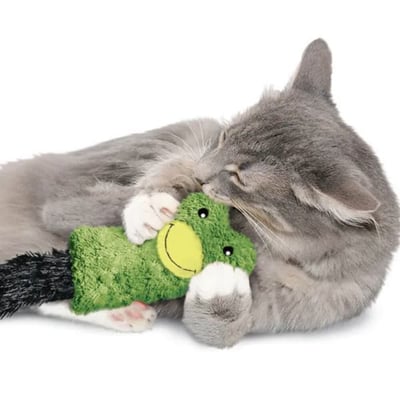
Many cats are attracted to the scent of catnip, so these toys stuffed with catnip may help encourage them to play:
These toys are big enough for your feline friend to wrestle around with and lightweight enough to be tossed around.
Cat Laser Toys
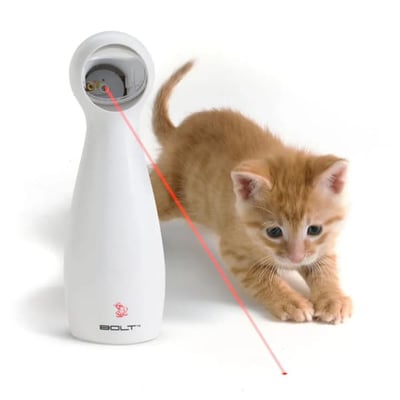
The Spot Rockin Laser Cat Toy encourages jumping, pouncing, and running. Simply place the laser toy in an accessible area of your home and turn it on. The weighted bird will bob and rock, moving the laser dot frantically and encouraging your cat to chase.
Learn if a laser pointer is right for your cat in Are Laser Pointers Bad for Cats?
Cat Track Toys

Another great option for solo playtime is cat track toys. Catit Senses offers several circuit track cat toys that all interlink so you can constantly change things up to hold your cat’s interest and curiosity.
With the Catit Senses 2.0 Super Circuit, wave and speed circuits are generated to encourage stalking and chasing behaviour. The Catit Senses Fireball 2.0 is a lighted LED ball that you can stuff with treats or catnip.
Hanging Cat Toys
.webp?width=400&height=400&name=kong-connects-window-teaser%20(1).webp)
You’ll encounter a wide assortment of hanging cat toys that will cling to windows or hang from a doorknob. Check out the Kong Window Cling Teaser, which is loaded with an abundance of catnip and even makes little crinkly noises to entice the kitty to continue playing when batted or chewed.
Motion Activation

When encouraging your cat to exercise, you’ll want to take a look at motion-activated toys such as the Catit Groovy Fish, which immediately starts to squirm and flop whenever it suspects your cat is near. The best thing about this toy is that it is fully interactive, and you don’t have to be present for kitty exercise.
Cat Wheel
This fun cat accessory isn't for everyone but can be a hugely beneficial tool for some cats. A cat wheel might seem a little silly, but this advanced exercise equipment can provide a bored cat with a safe and fun way to stay active indoors.
The downside is that a good quality cat wheel is expensive and takes up a lot of space in your home, but if you have exhausted all other methods, then you might want to consider a cat wheel.
Play Together
Some cats just aren’t that into toys, but if you play with the cat toys with them, they may find the games more fun. Your participation can encourage longer periods of activity than if your cat were alone.
Let your cat choose their favourite games. Some cats love games like fetch, so small tossable toys like cat balls or a feather toy are light enough for your cat to chase and bat around. Some cats will even bring them back.
Cat wands and teasers are also a great way to get your cat excited. The wands usually have feathers, ribbon, or small stuffed cat toys that your cat can chase, jump at, or tackle. Wand toys often encourage more intense activity.
Or combine these fun toys with a DIY cat obstacle course in your living room made from household items, like pillows, shelves, or even a cardboard box, to really get your kitty's blood pumping.
Cat Trees and Climbing
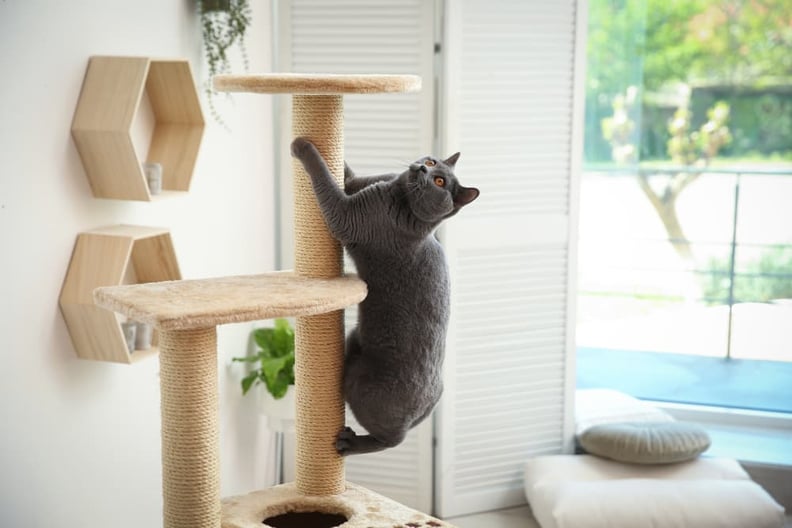
Cats love to climb cat trees. Partially because they love the higher vantage point of a tall tree but also because cat trees typically have multiple platforms and textures that your cat can scratch and jump to.
Climbing is a full-body cat workout. Things like furniture and stairs are great tools in your home to help up your cat's exercise intensity. If you prefer to keep your cat off your furniture, then it's time to invest in some cat furniture, like a cat tree.
Cat trees and cat furniture give your cat a safe and fun place to play, climb, scratch, and nap. They make great features in an obstacle course style game with your cat, too.
Look for a multi-story cat tree that is at least 3 ft tall. Use toys and wands to get your cat to climb up and down the cat tree for more intense cat workouts.
Leash Training Your Cat
Did you know that some cats like to go for walks? The great outdoors is like a whole new world to your cat, with exciting sounds and smells bombarding the senses.
Walking your cat on a leash is great for mental stimulation and gives your furry friend a healthy workout. So how do you train your cat to walk on a leash? Check out Leash Training Your Cat in 10 Easy Steps.
Teach Your Cat Tricks
Cats are highly intelligent and can quickly learn tricks, just like a dog. Although most felines have an independent streak and prove more challenging to teach, with patience and persistence, you can convince your feline to learn a few fun tricks that promote cat exercise.
Benefits of teaching your cat tricks include:
-
- Encourages exercise
- Helps with bonding
- Promotes alert behaviour
- Alleviates depression
- Stimulates mental abilities
Tips on teaching cat tricks:
-
- Train your cat frequently (several times a day).
- Repetition helps your cat learn quicker
- Use treats to train
- Keep training and play sessions short
- Train in a distraction-free environment
- Use a clicker to capture your cat’s attention
While teaching your cat tricks isn’t exactly a workout, it can be a useful tool in keeping your cat engaged. The tricks can be worked into your playtime routines to encourage a longer play session throughout the day.
Check out our 10 Favourite Cool Cat Tricks to Teach Your Cat.
Cat Exercise and Mental Stimulation

If you stimulate your cat mentally, then the cat will start to move around and exercise. A bored cat might sleep too much or become destructive. Providing cat puzzle toys to encourage thinking will entertain your kitty and promote physical fitness.
Cats are very picky about how they play. Simply providing them with cat toys is often not enough to get your cat exercising.
If you want to arouse your cat’s curiosity, then invest in cat puzzle toys. With a cat puzzle toy, your cat will learn how to solve a problem, exercise, and stimulate their mind.
Cat Food Puzzles
Cat food puzzles will encourage mental stimulation, exercise and weight loss. Your cat will feel excited about dinner but not overeat. Here are a few of our faves:
These are just a few of our favourite puzzle toys and puzzle feeders for cats. Hop over to Best Cat Puzzle Toys to Engage and Stimulate Your Cat.
Interactive Feeder Balls
An interactive feeder ball encourages even more exercise and movement as your cat manipulates the ball to gain a dry snack. Try these popular options:
Want more options? Our Interactive Cat Toys blog has plenty of suggestions to keep your cat’s mind active.
Take Kitten Steps
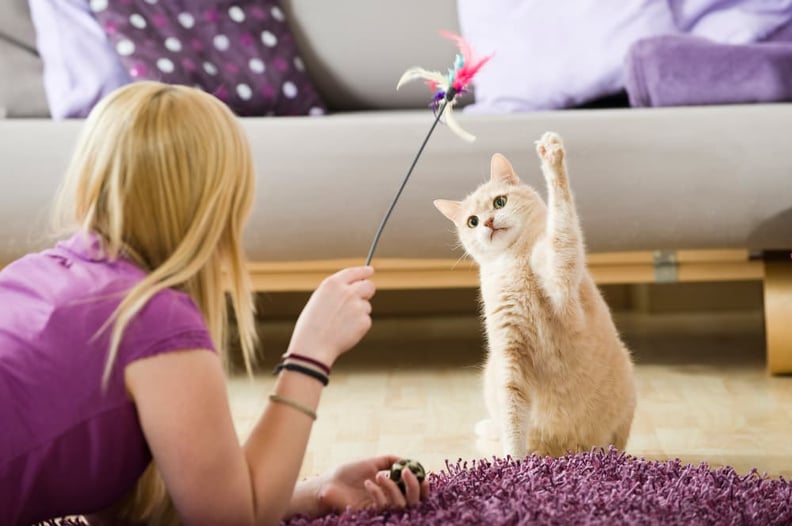
Studies have shown that 50% of all cats aged five to 11 years or older are overweight, with 30 to 35% being classified as obese. Obesity will shorten your cat’s life expectancy. With cat workouts, your furry friend can shed unwanted pounds, and experience improved health and greater mental well-being.
Start by finding games and toys that your cat enjoys and scheduling a short 3-5 minute play session a few times per day. Something as simple as a laser pointer or a feather toy or wand can quickly lure your cat into a rousing game.
Supplies like a small cat tree can be helpful accessories for encouraging play at a young age. You can graduate to larger cat furniture and toys as your cat grows.
As your cat builds stamina, you can increase play time and slowly start working on more exciting, higher-energy games.
With a little patience and practice, you can enjoy a daily cat exercise routine to keep him slim and healthy without sacrificing any of his regular nap time or couch cuddles.
Common Questions About Cat Exercise
Do cats need regular exercise?
Yes, regular cat workouts are important for cats to maintain a healthy weight, mental stimulation, and overall well-being. It helps prevent obesity and related health issues.
How much exercise do indoor cats require?
Indoor cats benefit from at least 20-30 minutes of active playtime daily. Engaging them in interactive toys, laser pointers, and climbing structures can fulfill their exercise needs.
What are the benefits of exercise for cats?
Exercise helps prevent boredom, reduces stress, maintains muscle tone, improves joint flexibility, and promotes mental stimulation, contributing to a happier and healthier cat.
Can outdoor cats get enough exercise on their own?
While outdoor cats naturally engage in more physical activity, it's still important to provide additional playtime and mental stimulation to both outdoor and indoor cats. Outdoor activities also expose them to potential risks.
How can I encourage my lazy cat to be active?
Gradually introduce new toys, interactive puzzles, and play sessions that mimic hunting behaviours. Experiment with different types of toys from your local pet store and a variety of activities to find what interests your cat.
Are there age-related considerations for cat exercise?
Yes, kittens and young cats tend to have higher energy levels and may require more playtime. Older cats may need gentler exercises that focus on joint mobility and mental stimulation.
.png?width=200&height=66&name=logo%20(1).png)


